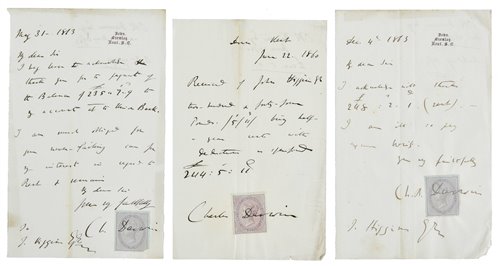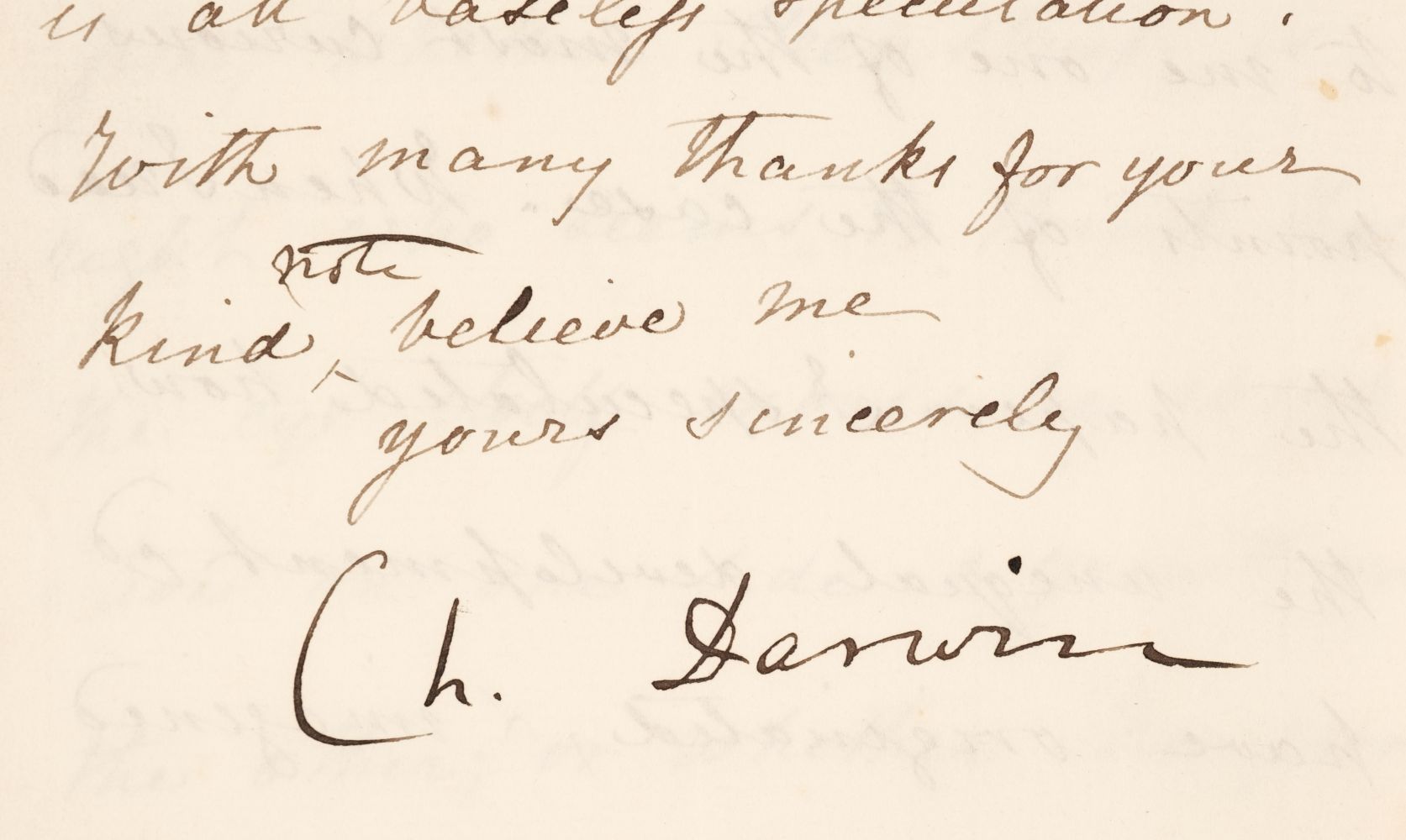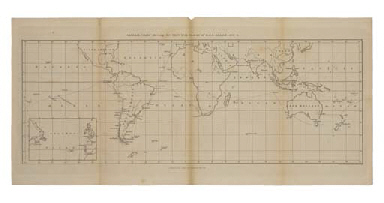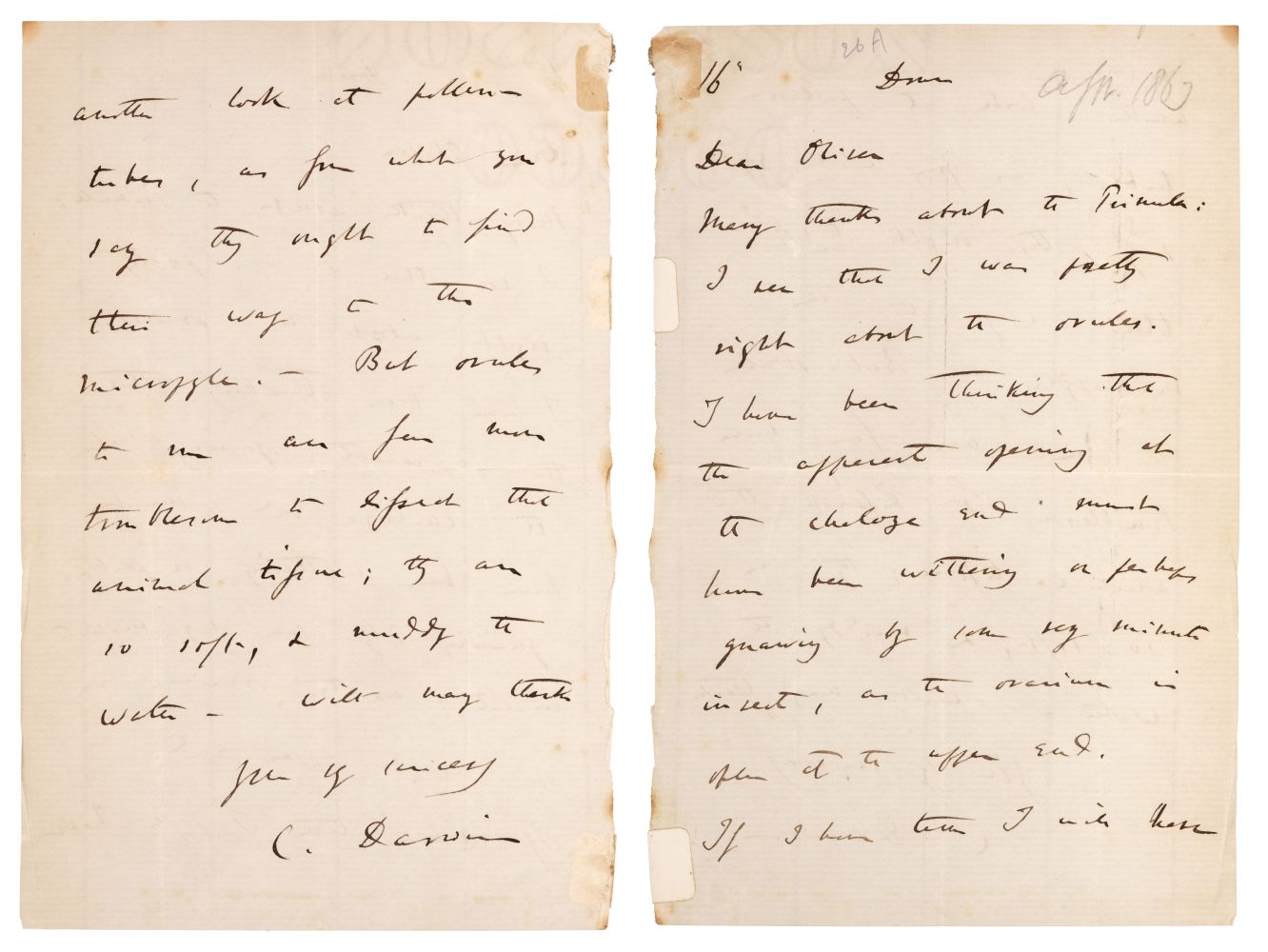DARWIN, Charles Robert (1809-1882). The Variation of Animals and Plants under Domestication ... Second edition, revised, fourth thousand . London: John Murray 1875. Author's presentation copy of his 'big book' on evolution by natural selection, with 11 revisions in the hand of Darwin's amanuensis. 'This represents the only section of Darwin's big book on the origin of species which was printed in his lifetime and corresponds to its first two intended chapters' (Freeman, p.122). The gestation of Darwin's theories was extremely long, starting with his observations and findings on the Beagle voyage, culminating over many years of painstaking research with an unwieldy 250,000 word treatise entitled 'Natural Selection' that was far from complete. Wallace's letter of June 1858 forced Darwin into writing an abstract of this work called On the Origin of Species . However, Darwin was determined to publish the research that had led him to the Origin , and work on Variation began two days after the second edition of the Origin appeared on 7 January 1860. Along with the ascertainable facts of artificial selection, it contained Darwin's hypothesis of pangenesis. Francis Darwin recorded that 'about half of the eight years that elapsed between its commencement and completion were spent on it. The book did not escape adverse criticism: it was said, for instance, that the public had been patiently waiting for Mr. Darwin's pièces justicatives , and that after eight years of expectation all they got was a mass of detail about pigeons, rabbits and silk worms. But the true critics welcomed it as an expansion with unrivalled wealth of illustration of a section of the Origin ' ( The Autobiography of Charles Darwin and Selected Letters , ed. F. Darwin, New York, 1958, p. 281). The book's slow progress towards publication was due not only to its size, but also the author's ill health. It was finally published on 30 January 1868, the first issue consisting of 1500 copies. For this second edition, the text was substantially revised, and the format reduced in size to crown octavo. It is the final edition of the text – all subsequent editions were printed from stereotyped plates. There were 25 recipients of presentation copies of this second edition (Darwin Correspondence, vol. 24, p.596f.), including the German J. Victor Carus, and the Italian Giovanni Canestri, the translators of the 3rd German (1878; Freeman 916) and first Italian (1876; Freeman 920) editions respectively. It is possible that this copy is one of these, since the corrections, although of a minor nature, correspond largely with revisions in those editions. These textual corrections are found on pp. 170, 262, 264, 425, 434 and 442 of vol. I; and in the index only, on pp.431, 439, 450, 456 and 461 of vol. II. The hand is identifiable as that of Francis Darwin, Charles' amanuensis at that period. The book block has been shaved to spare Darwin's recipients of presentation copies the trouble of opening the gatherings, and the inscription in Darwin's own hand – rather than in the hand of the publisher's clerk as often found – suggests this is an important association copy. Freeman 880. 2 volumes, crown octavo (185 x 120mm). Second edition. 43 woodblocks in text. Vol. II with 32p. advertisements for John Murray's books dated January 1876 (ight spotting on titles.) Original green cloth, arches style, with covers stamped with blind frame, gilt spines (extremities rubbed). Provenance : Charles Darwin (presentation inscription on front free endpaper).
DARWIN, Charles Robert (1809-1882). The Variation of Animals and Plants under Domestication ... Second edition, revised, fourth thousand . London: John Murray 1875. Author's presentation copy of his 'big book' on evolution by natural selection, with 11 revisions in the hand of Darwin's amanuensis. 'This represents the only section of Darwin's big book on the origin of species which was printed in his lifetime and corresponds to its first two intended chapters' (Freeman, p.122). The gestation of Darwin's theories was extremely long, starting with his observations and findings on the Beagle voyage, culminating over many years of painstaking research with an unwieldy 250,000 word treatise entitled 'Natural Selection' that was far from complete. Wallace's letter of June 1858 forced Darwin into writing an abstract of this work called On the Origin of Species . However, Darwin was determined to publish the research that had led him to the Origin , and work on Variation began two days after the second edition of the Origin appeared on 7 January 1860. Along with the ascertainable facts of artificial selection, it contained Darwin's hypothesis of pangenesis. Francis Darwin recorded that 'about half of the eight years that elapsed between its commencement and completion were spent on it. The book did not escape adverse criticism: it was said, for instance, that the public had been patiently waiting for Mr. Darwin's pièces justicatives , and that after eight years of expectation all they got was a mass of detail about pigeons, rabbits and silk worms. But the true critics welcomed it as an expansion with unrivalled wealth of illustration of a section of the Origin ' ( The Autobiography of Charles Darwin and Selected Letters , ed. F. Darwin, New York, 1958, p. 281). The book's slow progress towards publication was due not only to its size, but also the author's ill health. It was finally published on 30 January 1868, the first issue consisting of 1500 copies. For this second edition, the text was substantially revised, and the format reduced in size to crown octavo. It is the final edition of the text – all subsequent editions were printed from stereotyped plates. There were 25 recipients of presentation copies of this second edition (Darwin Correspondence, vol. 24, p.596f.), including the German J. Victor Carus, and the Italian Giovanni Canestri, the translators of the 3rd German (1878; Freeman 916) and first Italian (1876; Freeman 920) editions respectively. It is possible that this copy is one of these, since the corrections, although of a minor nature, correspond largely with revisions in those editions. These textual corrections are found on pp. 170, 262, 264, 425, 434 and 442 of vol. I; and in the index only, on pp.431, 439, 450, 456 and 461 of vol. II. The hand is identifiable as that of Francis Darwin, Charles' amanuensis at that period. The book block has been shaved to spare Darwin's recipients of presentation copies the trouble of opening the gatherings, and the inscription in Darwin's own hand – rather than in the hand of the publisher's clerk as often found – suggests this is an important association copy. Freeman 880. 2 volumes, crown octavo (185 x 120mm). Second edition. 43 woodblocks in text. Vol. II with 32p. advertisements for John Murray's books dated January 1876 (ight spotting on titles.) Original green cloth, arches style, with covers stamped with blind frame, gilt spines (extremities rubbed). Provenance : Charles Darwin (presentation inscription on front free endpaper).

.jpg)





.jpg)
.jpg?w=400)



.jpg)
.jpg)
.jpg)
Testen Sie LotSearch und seine Premium-Features 7 Tage - ohne Kosten!
Lassen Sie sich automatisch über neue Objekte in kommenden Auktionen benachrichtigen.
Suchauftrag anlegen